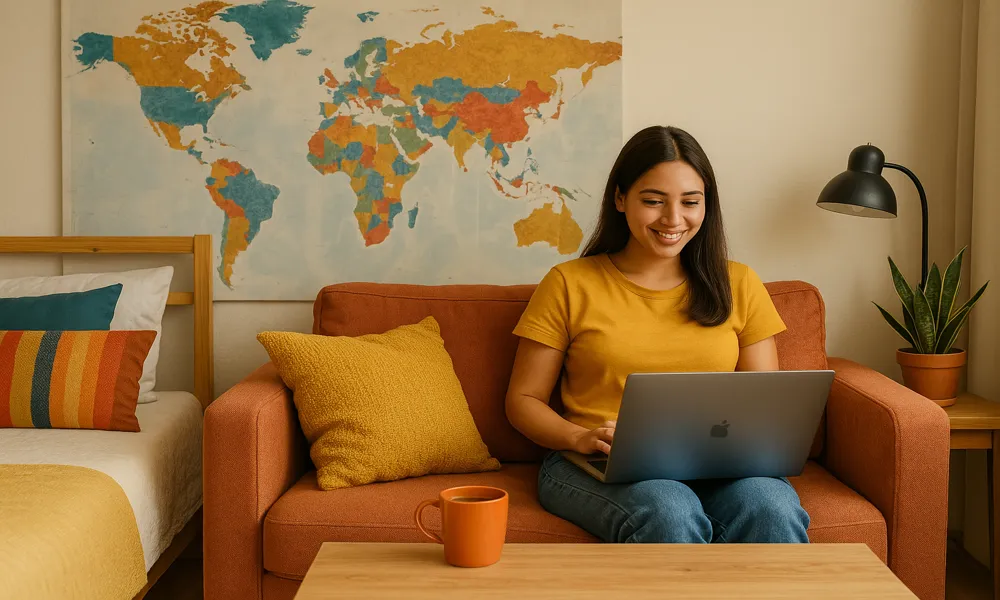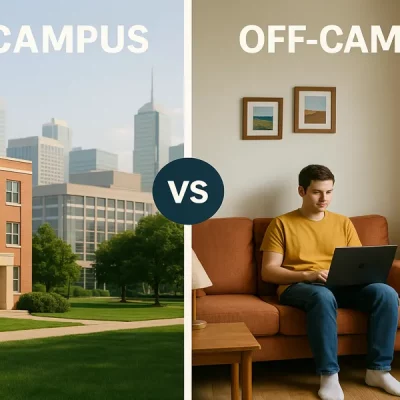The Complete Guide to Student Accommodation: Types, Benefits, and Booking Tips
Table of Contents
Heading to university soon and wondering where you’ll live? You’re not alone! Finding the right student accommodation is one of the biggest decisions you’ll make when studying abroad. Whether you’re after a social shared flat or quiet off campus student housing, there’s something for everyone. From furnished studios to budget-friendly shared rooms, student housing has come a long way—and this guide will help you navigate all of it. Let’s break it down—from types and amenities to pricing and how to book your ideal student home with ease!
What is the meaning of student accommodation?
Student accommodation refers to housing that’s specifically designed or curated for students enrolled in colleges or universities. Unlike regular rental housing, student accommodations focus on convenience, affordability, and community living. These living spaces are often located near or within university campuses and are managed either by the university or by private housing providers.
They typically come fully furnished, include essential amenities like Wi-Fi, study desks, and communal areas, and offer flexible lease options aligned with academic calendars. Whether you’re moving in for a semester or staying through your entire degree program, student accommodations are designed to support both your academic success and your lifestyle.
What is the most common type of accommodation for university students?
The most common type of accommodation for university students is shared apartments and off-campus student housing. These options are popular because they’re affordable, flexible, and offer a strong sense of independence and community. Students often choose them to enjoy more privacy, better amenities, and the opportunity to live with friends or roommates.
In fact, over 70% of international students in 2024 preferred off campus housing or Purpose-Built Student Accommodations (PBSAs) for the comfort and freedom they provide compared to traditional dorms. Here’s a detailed breakdown of the most common types of accommodation for university students:
- Shared Apartments: Shared apartments are for students who want to save money and enjoy a social lifestyle. In this setup, students typically share a kitchen, living room, and sometimes bathrooms. The average monthly rent for a shared apartment ranges between $500 – $1,000.
- Studios: Studios are perfect for students who value privacy. These self-contained units come with a private kitchen and bathroom. Expect to pay around $1,200 – $1,800/month for a studio apartment.
- En-suite Rooms: In en-suite rooms students get a private bathroom while sharing a common kitchen area with housemates. These rooms typically cost between $900 – $1,400/month.
- University Dormitories: Managed directly by the university, dormitories are popular among first-year students. They often include meal plans, security, and easy access to campus resources like libraries and academic support. Prices generally fall between $600 – $1,200/month.
- Off Campus Housing: Off campus housing refers to privately rented apartments or shared houses near the university. Costs can vary widely but usually range from $800 – $1,500/month, depending on amenities, location, and size.
- PBSAs: PBSAs are modern housing complexes that often feature private or en-suite rooms, along with top-notch amenities like gyms, study lounges, and social spaces. The monthly cost typically ranges from $1,000 – $1,800.
What Is HMO Property? A Complete Guide to Houses in Multiple Occupation
What is Included in Student Accommodation?
Most places come fully equipped with the essentials, so you don’t have to worry about buying furniture or setting up utilities. From a comfy bed to high-speed Wi-Fi, student housing is often all-inclusive, though it’s always smart to double-check your lease for what’s actually covered. Here’s what you can typically expect to be included in student accommodation:
- Furnished Room: Almost all student accommodations come with basic furniture like a bed, study desk, chair, and wardrobe. It’s all set up for study and rest, so no need to bring your own furniture.
- Wi-Fi & Utilities: Internet, electricity, water, and heating are often bundled into the rent—especially in PBSAs and most off campus housing. However, in some cases, you may need to pay separately for Wi-Fi or utilities, so always confirm in advance.
- Laundry Access: Most places either have shared laundry rooms or in-unit washers and dryers. Some might be coin-operated, while others are free to use.
- Study Areas: Purpose-built student accommodation often includes quiet study zones, so you don’t always have to go to the library to get your work done.
- 24/7 Security & Maintenance: Most accommodations offer round-the-clock security and on-site maintenance teams, giving you peace of mind if anything needs fixing.
- Gym & Fitness Facilities: While not guaranteed everywhere, many off campus accommodation complexes and PBSAs offer access to gyms or workout areas as part of the package.
How student accommodation is different from hostels?
At first glance, student accommodations and hostels might seem similar—both provide a place to sleep, shared amenities, and social interaction. But when it comes to purpose, privacy, and duration, they are very different. While hostels are great for short stays and travel purposes, student accommodations are built to support a student’s academic journey—providing the peace, structure, and long-term stability you need during college or university. Here’s a detailed breakdown of the key differences between a student accommodation and hostel:
| Feature | Student Accommodation | Hostels |
| Lease Length | Long-term lease (semester, academic year, or full course duration) | Short-term stays (daily, weekly, or monthly) |
| Privacy | High – options like en-suites, studios, and private apartments available | Low – mostly dormitory-style, shared with multiple travelers or guests |
| Study Environment | Quiet, academic-focused spaces with study rooms or desks in each room | Often noisy, social, and not designed for studying |
| Facilities | Tailored for student life – Wi-Fi, study areas, laundry, gyms, 24/7 support, community events | Basic – bed, shared kitchen/bathroom, limited amenities |
| Security | Monitored entrances, keycard access, CCTV, 24/7 staff support | Limited security – usually just front desk check-ins |
| Length of Stay | Ideal for full-time students who need accommodation for the duration of their course | Ideal for tourists or students needing very short-term transitional stays |
| Cost Structure | Monthly or semester-based rent; often all-inclusive | Pay per night or week; may have hidden charges for Wi-Fi or lockers |
| Community | Built-in peer network, often with university or academic ties | Random mix of travelers, backpackers, or short-term guests |
| Location | Typically close to university campuses, libraries, and academic centers | Closer to tourist spots or transportation hubs |
How Long Can You Stay in Student Accommodation?
The length of your stay in student accommodation usually depends on the type of lease you sign and the housing provider—whether it’s university-managed or private off campus accommodation. While on-campus housing often aligns with the university calendar, off campus student housing providers usually offer more flexible lease options to cater to both short-term and long-term academic needs. Following is the typical breakdown of lease duration in student accommodations:
- Semester Lease: It is usually for 4–6 months. Ideal for exchange students or short-term academic stays.
- Academic Year Lease: It’s duration is of 9–12 months. Most popular option among undergraduates and postgraduates.
- Multi-Year Lease: 2–4 years. Suited for full-time students who prefer long-term stability.
- Summer/Short-Term Stay: This one is for 1–3 months. Ideal for internships, research work, or summer school.
- Month-to-Month Lease: It is common for off campus housing; offers maximum flexibility with higher cost.
What are the benefits of student accommodations?
Student accommodation isn’t just about having a place to sleep—it’s about creating a lifestyle that supports your academics, social life, and overall well-being. Whether you choose on-campus housing or off campus student housing, the benefits go far beyond convenience. These living spaces are tailored to the needs of university students, offering everything from academic support to built-in social opportunities. Here’s a detailed breakdown of the key benefits of student accommodations:
- Proximity to Campus: Being just minutes away from classes, libraries, and labs means less commuting, more time for studying, socializing, or even sleeping in!
- Furnished Spaces: Rooms typically come with beds, desks, chairs, and wardrobes—so no need to haul furniture from home or worry about setup costs.
- Safety & Security: Most buildings offer 24/7 security, CCTV, secure entry, and on-site staff, giving students and parents peace of mind.
- Utility Bills Included: Water, electricity, gas, and Wi-Fi are usually bundled into the rent—making it easier to manage monthly expenses without surprise costs.
- Flexibility in Lease Terms: Especially in off campus accommodation, you often have the option to choose semester, academic year, or month-to-month leases.
What is the average cost of student accommodation?
In 2025, the average monthly cost of student accommodation continues to rise slightly due to inflation and increased demand—but the good news is, there’s something for every budget. Cities like London, New York, Sydney, and Toronto tend to be on the higher end of the price range, while smaller cities or student towns like Nottingham, Adelaide, or Gainesville are usually more affordable. Here’s what you can typically expect to pay per month depending on the type of accommodation you choose:
| Location Type | Average Monthly Rent (USD) | What’s Usually Included |
| On-Campus Housing | $600 – $1,200 | Furnished room, utilities, Wi-Fi, access to study lounges |
| Off Campus Housing | $800 – $1,500 | Private/shared rooms, sometimes includes bills, more flexibility |
| Studio Apartments | $1,200 – $1,800 | Private kitchen, bathroom, higher privacy, utilities vary |
| Shared Rooms | $500 – $1,000 | Shared bathroom/kitchen, lower cost, good for social living |
How Can You Book Student Accommodation?
Booking your student accommodation doesn’t have to be stressful—especially when you have platforms like University Living by your side. With the right planning and a little guidance, you can secure your ideal student room well before your classes begin. University Living makes this process incredibly smooth. With over 2 million verified rooms in 400+ global cities, we offer 24/7 expert assistance, virtual tours, zero hidden charges, and even help with airport pickups, room transfers, and local support after you move in. Below is step by-step process to book student accommodation through University Living:
- Browse and Filter Options: Use smart filters to refine your search based on budget, distance to campus, room type (studio, ensuite, shared), and amenities like gym, laundry, or Wi-Fi.
- Compare Listings: Check property photos, student reviews, location maps, rent details, lease terms, and see what’s included in the rent (bills, furniture, internet, etc.).
- Speak to an Expert: You can chat live with a booking expert or request a callback for personalized advice. They’ll help you shortlist the best accommodation based on your needs.
- Request Virtual Tours: Not sure about the property? Ask for a virtual tour of the shortlisted rooms so you know exactly what you’re booking.
- Confirm Your Booking: Once you’ve chosen your room, the team will guide you through the booking form, lease agreement, and deposit payment process. Everything is online and hassle-free.
Conclusion
And there you have it—your complete guide to student accommodation made easy! From understanding what’s included in your rent to choosing between on-campus dorms and flexible off campus accommodation, your perfect student home is just a few clicks away. Remember, University Living is here to make your journey smoother. So why wait? Start early, explore all your options, and get ready to live your best university life—because where you stay is just as important as where you study!
Frequently Asked Questions
What is student accommodation and how is it different from a regular rental?
Student accommodation refers to housing that is specifically designed for university or college students. Unlike regular rentals, it includes furniture, Wi-Fi, utility bills, and flexible leases that match your academic calendar. You’ll also find community events, study spaces, and often 24/7 support—features tailored to student life.
Which type of student accommodation is the most popular?
Shared apartments and off campus student housing are the most common choices among students in 2025. They’re budget-friendly, offer more privacy, and let you live with friends. In fact, over 70% of international students in 2024 preferred off campus accommodation or PBSAs for better facilities and more freedom.
What amenities are included in student accommodation?
Most student accommodations come fully furnished and include high-speed Wi-Fi, electricity, water, heating, and access to laundry, study lounges, and sometimes gyms. Always double-check your lease though—some utilities might be charged separately, especially in off campus housing.
How is student accommodation different from hostels?
Unlike hostels, which are made for short-term stays, student accommodation is long-term, more private, and study-focused. It includes quiet spaces, desks, and 24/7 support. Hostels are typically noisier, cheaper per night, and offer fewer amenities and security features.
How long can I stay in student accommodation?
It depends on your lease. You can usually choose from semester leases (4–6 months), academic year leases (9–12 months), or even multi-year leases (up to 4 years). Off campus accommodation often allows month-to-month stays if you prefer flexibility.
What are the benefits of staying in student accommodation?
There are many! You’ll enjoy proximity to campus, furnished rooms, included bills, 24/7 security, and a built-in student community. Whether on-campus or off campus, student housing is designed to make your university life easier, safer, and more social.








